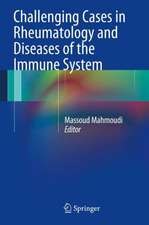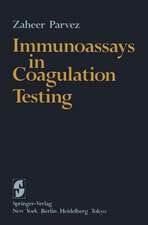Food Allergens: Biochemistry and Molecular Nutrition: Food Microbiology and Food Safety
Autor Tanja Ćirković Veličković, Marija Gavrović-Jankulovićen Limba Engleză Hardback – 24 iun 2014
Some biochemical characteristics associated with food allergens, such as the presence of multiple, linear IgE-binding epitopes and the resistance of the protein to digestion and processing, seem to predominate among food allergens. Digestion susceptibility of food allergens that sensitize via the gastrointestinal tract and stability to food processing conditions are inherently related to protein structural features. Thereby, physiological changes in the digestion process, pathological conditions affecting digestion, as well as procedures and food processing conditions that affect protein structure may all have a profound effect on the sensitizing potential and allergenicity of food proteins. In addition, signals coming from the diet and micro biome can modulate regulatory mechanisms of the mucosal immune system and influence mucosal immunity and intestinal barrier function.
The detection of allergenic ingredients in food products has received increased attention from the food industry and legislative and regulatory agencies over recent years. This has resulted in the improvement of applied safety measures that provide protection for food-allergic consumers and development of sensitive and highly specific analytical methods of food allergens detection. Food allergy is an important and common health issue and therefore there is a need to characterize the sensitizing potential of newly introduced proteins in genetically engineered foods. A combination of in vitro and in silico methods provide information thatcontributes to safety assessment. Suitable in vivo models may provide a more holistic assessment of allergenic potential of novel food proteins.
| Toate formatele și edițiile | Preț | Express |
|---|---|---|
| Paperback (1) | 636.80 lei 6-8 săpt. | |
| Springer – 3 sep 2016 | 636.80 lei 6-8 săpt. | |
| Hardback (1) | 718.65 lei 6-8 săpt. | |
| Springer – 24 iun 2014 | 718.65 lei 6-8 săpt. |
Din seria Food Microbiology and Food Safety
- 18%
 Preț: 1396.43 lei
Preț: 1396.43 lei - 20%
 Preț: 565.93 lei
Preț: 565.93 lei - 18%
 Preț: 1244.89 lei
Preț: 1244.89 lei - 15%
 Preț: 639.73 lei
Preț: 639.73 lei - 18%
 Preț: 785.86 lei
Preț: 785.86 lei - 15%
 Preț: 709.44 lei
Preț: 709.44 lei - 18%
 Preț: 951.29 lei
Preț: 951.29 lei - 18%
 Preț: 1118.75 lei
Preț: 1118.75 lei -
 Preț: 389.70 lei
Preț: 389.70 lei - 5%
 Preț: 398.11 lei
Preț: 398.11 lei - 15%
 Preț: 633.68 lei
Preț: 633.68 lei - 18%
 Preț: 1384.26 lei
Preț: 1384.26 lei - 18%
 Preț: 1486.83 lei
Preț: 1486.83 lei - 23%
 Preț: 906.44 lei
Preț: 906.44 lei -
 Preț: 389.88 lei
Preț: 389.88 lei - 18%
 Preț: 782.87 lei
Preț: 782.87 lei - 18%
 Preț: 1111.97 lei
Preț: 1111.97 lei - 15%
 Preț: 645.28 lei
Preț: 645.28 lei - 18%
 Preț: 722.58 lei
Preț: 722.58 lei - 18%
 Preț: 771.49 lei
Preț: 771.49 lei - 15%
 Preț: 712.05 lei
Preț: 712.05 lei - 18%
 Preț: 892.42 lei
Preț: 892.42 lei - 18%
 Preț: 1107.73 lei
Preț: 1107.73 lei - 15%
 Preț: 471.53 lei
Preț: 471.53 lei - 18%
 Preț: 1228.29 lei
Preț: 1228.29 lei - 18%
 Preț: 1236.51 lei
Preț: 1236.51 lei - 18%
 Preț: 1388.68 lei
Preț: 1388.68 lei - 18%
 Preț: 1217.41 lei
Preț: 1217.41 lei - 18%
 Preț: 1386.92 lei
Preț: 1386.92 lei - 18%
 Preț: 796.76 lei
Preț: 796.76 lei
Preț: 718.65 lei
Preț vechi: 756.47 lei
-5% Nou
Puncte Express: 1078
Preț estimativ în valută:
137.53€ • 149.34$ • 115.53£
137.53€ • 149.34$ • 115.53£
Carte tipărită la comandă
Livrare economică 22 aprilie-06 mai
Preluare comenzi: 021 569.72.76
Specificații
ISBN-13: 9781493908400
ISBN-10: 1493908405
Pagini: 208
Ilustrații: XIII, 208 p. 19 illus., 9 illus. in color.
Dimensiuni: 155 x 235 x 18 mm
Greutate: 0.49 kg
Ediția:2014
Editura: Springer
Colecția Springer
Seriile Food Microbiology and Food Safety, Research and Development
Locul publicării:New York, NY, United States
ISBN-10: 1493908405
Pagini: 208
Ilustrații: XIII, 208 p. 19 illus., 9 illus. in color.
Dimensiuni: 155 x 235 x 18 mm
Greutate: 0.49 kg
Ediția:2014
Editura: Springer
Colecția Springer
Seriile Food Microbiology and Food Safety, Research and Development
Locul publicării:New York, NY, United States
Public țintă
ResearchCuprins
Food allergy and gastrointestinal tract.- Intestinal permeability and transport of food antigens.- Biochemistry and molecular biology of food allergens.- Methods for allergen identification and quantification in food matrices.- Food allergens digestibility.- Micro biota and allergic disease.- Phytochemicals and hypersensitivity disorders.- Predicting potential allergenicity of new proteins introduced by biotechnology.
Textul de pe ultima copertă
A food allergen has the ability to first elicit an IgE response, and then, on subsequent exposures, a clinical response to the same or similar protein. How harmless food protein becomes recognized by the mucosal immune system as an allergen remains an open question and more data are needed to explain how regulatory mechanisms of the mucosal immune system fail and result in allergic sensitization to dietary antigens.
Some biochemical characteristics associated with food allergens, such as the presence of multiple, linear IgE-binding epitopes and the resistance of the protein to digestion and processing, seem to predominate among food allergens. Digestion susceptibility of food allergens that sensitize via the gastrointestinal tract and stability to food processing conditions are inherently related to protein structural features. Thereby, physiological changes in the digestion process, pathological conditions affecting digestion, as well as procedures and food processing conditions that affect protein structure may all have a profound effect on the sensitizing potential and allergenicity of food proteins. In addition, signals coming from the diet and microbiome can modulate regulatory mechanisms of the mucosal immune system and influence mucosal immunity and intestinal barrier function.
The detection of allergenic ingredients in food products has received increased attention from the food industry and legislative and regulatory agencies over recent years. This has resulted in the improvement of applied safety measures that provide protection for food-allergic consumers and development of sensitive and highly specific analytical methods of food allergens detection. Food allergy is an important and common health issue, and therefore there is a need to characterize the sensitizing potential of newly introduced proteins in genetically engineered foods. A combination of in vitro and in silico methods provide information that contributes to safety assessment. Suitable in vivo models may provide a more holistic assessment of allergenic potential of novel food proteins. The Food Microbiology and Food Safety series is published in conjunction with the International Association for Food Protection, a non-profit association for food safety professionals. Dedicated to the life-long educational needs of its Members, IAFP provides an information network through its two scientific journals (Food Protection Trends and Journal of Food Protection), its educational Annual Meeting, international meetings and symposia, and interaction between food safety professionals.
Some biochemical characteristics associated with food allergens, such as the presence of multiple, linear IgE-binding epitopes and the resistance of the protein to digestion and processing, seem to predominate among food allergens. Digestion susceptibility of food allergens that sensitize via the gastrointestinal tract and stability to food processing conditions are inherently related to protein structural features. Thereby, physiological changes in the digestion process, pathological conditions affecting digestion, as well as procedures and food processing conditions that affect protein structure may all have a profound effect on the sensitizing potential and allergenicity of food proteins. In addition, signals coming from the diet and microbiome can modulate regulatory mechanisms of the mucosal immune system and influence mucosal immunity and intestinal barrier function.
The detection of allergenic ingredients in food products has received increased attention from the food industry and legislative and regulatory agencies over recent years. This has resulted in the improvement of applied safety measures that provide protection for food-allergic consumers and development of sensitive and highly specific analytical methods of food allergens detection. Food allergy is an important and common health issue, and therefore there is a need to characterize the sensitizing potential of newly introduced proteins in genetically engineered foods. A combination of in vitro and in silico methods provide information that contributes to safety assessment. Suitable in vivo models may provide a more holistic assessment of allergenic potential of novel food proteins. The Food Microbiology and Food Safety series is published in conjunction with the International Association for Food Protection, a non-profit association for food safety professionals. Dedicated to the life-long educational needs of its Members, IAFP provides an information network through its two scientific journals (Food Protection Trends and Journal of Food Protection), its educational Annual Meeting, international meetings and symposia, and interaction between food safety professionals.
Caracteristici
Identifies the components of foods that can influence food allergy development Discusses 'molecular nutrition' as it relates to food allergies Provides a detailed study of the most important and common food allergens Includes supplementary material: sn.pub/extras



















